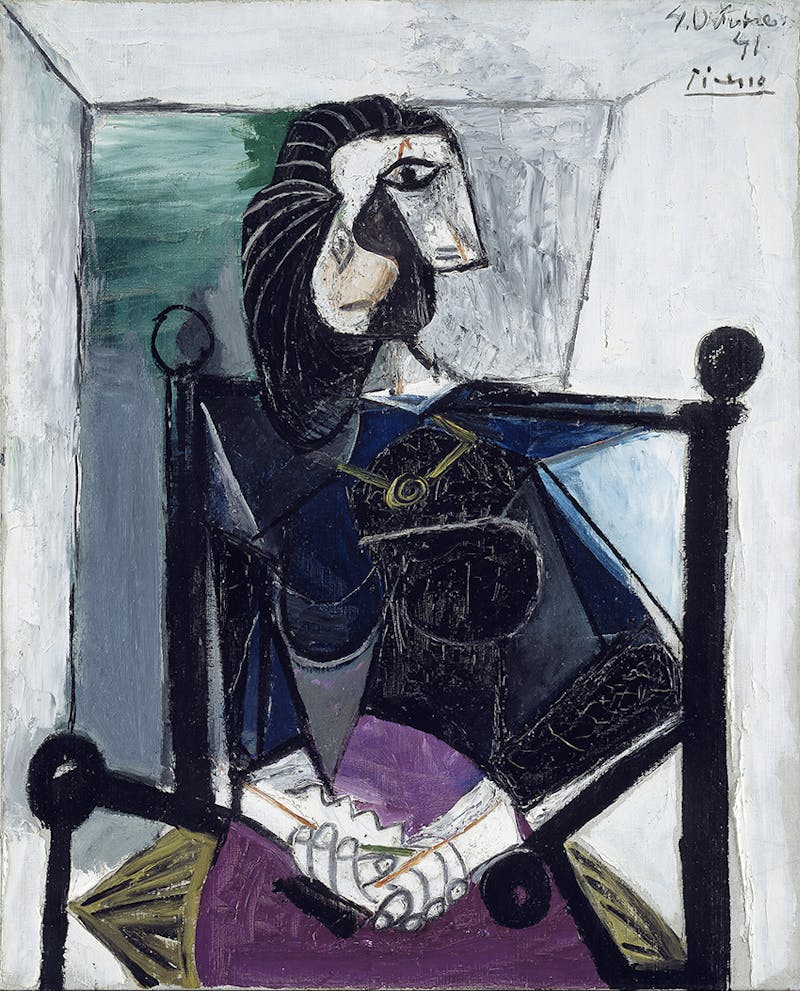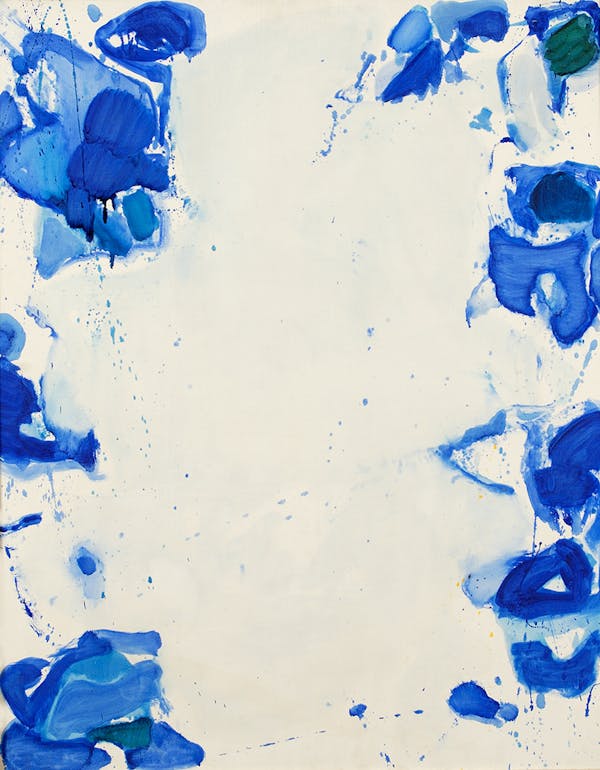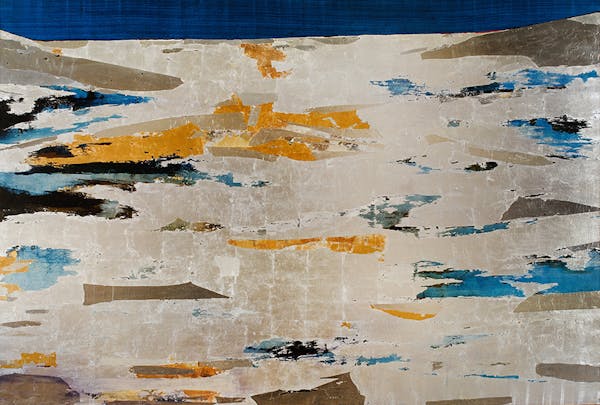The Henie Onstad Collection

↑ Pablo Picasso, Woman in Arm Chair, 1941. © Succession Pablo Picasso / BONO.
Henie Onstad Collection. Photo: Øystein Thorvaldsen.

↑ Maria Helena Vieira da Silva, L´Embarcadère / The Wharf, 1955.
Henie Onstad Collection. Photo: Øystein Thorvaldsen.
The Henie Onstad Collection
Our strategy today aims to collect women as well as artists from a broad geographical area.
Sonja Henie’s interest for paintings started when she met Niels Onstad in 1955. He was already an art collector. They were modern people of their time and mostly collected young, international art. More than anything they were searching for beauty; «things which will bring joy to the eyes and peace to the mind» director Ole Henrik Moe wrote for the opening of the Art Center in 1968.
At the inauguration of The Sonja Henie and Niels Onstad Foundation in 1961 the Sonja Henie and Niels Onstad Collection counted 100 paintings. When The Henie Onstad Kunstsenter opened its doors in 1968 the number of paintings had increased to 200.
The Sonja Henie and Niels Onstad Collection joined the European collector’s tradition at the time by looking to France. We can find names like Juan Gris, Jacques Villon, Pablo Picasso and Pierre Bonnard. Most gravitate toward 1950’s art and especially two distinctive main directions: the Parisian lyrical style, inspired by nature and also partly abstract geometrical paintings. We also had the more brutal Nordic Expressionism as expressed by the CoBrA artists, among others.
Throughout the 50 years the Art Center has existed, the collection has continued to grow and to embrace different directions. Some main tendencies in the collection today is the dialog with Surrealism, the CoBrA art, the geometrical abstraction with directions to concrete art and op art, the abstract lyrical painting as well as the Fluxus collections.
- As collectors, Sonja Henie and Henie Onstad had a very strong and personal involvement and close friendships with the artists they collected. Sonja Henie and Niels Onstad were contemporary, people of their time and their collection reflects this. For example, they collected notably few women and mainly European paintings. Today the Henie Onstad Kunstsenter has a different approach to the development of the collection. Our strategy aims to collect women as well as artists from a broad geographical area, says head curator Caroline Ugelstad.
Since 2009 the savings bank, Sparebankstiftelsen DNB has together with the Henie Onstad built a substantial collection of art by the German artist Kurt Schwitters (1887-1948). The artworks are in Henie Onstad’s possession indefinitely and they have a permanent place in one of the rooms at the Art Center. Schwitters is considered one of the most innovative and influential artists of the last century. He experimented across media and worked with sound, text, image, architecture, collages and paintings. He referred to this method of working as «Merz».
The political situation in nazi Germany worsened during the 1930’s. On January 2nd in 1937 Schwitters fled from Hannover to Norway to meet up with his son Ernst Schwitters, who had travelled ahead of him. The very same year his Merz-art was included in the nazi exhibition titled «Entartete Kunst»1 in Munich. This made it impossible for Schwitters to return to Germany. Schwitter’s wife Helma remained in Hannover and they never met again.
Schwitters lived in Norway for many years and he built two so-called Merzbaus here. One at Hjertøya just outside of Molde and one in Fagerhøyveien by Lysaker, the latter one burnt down. At Henie Onstad Kunstsenter you can experience the greatest permanent exhibition by Schwitters outside Germany. The exhibition draws attention to his attachment to Norway. At the same time, it presents work by concurrent artists within the Dada and Surrealism universe, as well artists who were inspired by his work.
The Henie Onstad Fluxus Collection was established in the end of the 1980’s. Through the Art Center’s history of interdisciplinary art as well as the close connection to the artist Ken Friedman, Henie Onstad was in a unique position with direct access to the experimental Fluxus movement. The movement is known for working in an interdisciplinary fashion, artistically blending different media in their work.
The Fluxus network arouse in the transition to the 1960’s and remained active until the end of the 1970’s. The activities it embraced included concerts, festivals, plays, innovative designed publications (including notations of electronic music), distribution of objects, mail art and concrete poetry, as well as volatile happenings and actions based on everyday life. The Fluxus name derives from the Latin word for «flow» and was originally used by the Fluxus artist George Maciunas.
Entartete Kunst, also called «Degenerate art», was the German National Socialist movement’s name for modernist visual art. It is also the name of an idealogical campaign the nazis started against art they found to be unnatural or figurative. The nazis used the word in a derogatory manner when referring to the new art forms which developed in the 20th Century, being more experimental, spontaneous, boundless and challenging than ever before. «Entartete Kunst» was also the name of a propaganda exhibition which opened in Munich on July 19th in 1937 and which carried on, on tour.
Great parts of the Henie Onstad Fluxus Collection was in 2007 donated to the Art Center by Fluxus artist and professor Ken Friedman. The collection has been given the name Ken Friedman Fluxus Collection. Artists such as Geoffrey Hendricks, Nam June Paik and Al Hansen have also donated Fluxus works in relation to exhibitions at the Art Center. These are part of the main collection of Henie Onstad Kunstsenter.
Parts of the Fluxus Collection will be permanently on display in the Avantgarde hall at the Art Center.
In 2013 the Henie Onstad Kunstsenter acquired Jean Brown Personal Papers, a large Avant-garde archive and collection of studies assembled by the American librarian and collector Jean Brown (1911-1994). Her home became an important center for the Fluxus artists and others who were interested, as Jean Brown alternately would cook meals and present the archive to her guests.
The archive contains publications, paperwork and art within Dada and Surrealism and it is extended to Avant-garde movements and networks like concrete poetry, mail art and Fluxus. Great parts of the archive where bought in 1985 by the Getty Research Foundation in Los Angeles, California. Brown did however keep parts of the material as well as her personal archive of correspondence. This is the material which is in the possession of Henie Onstad Kunstsenter today. Henie Onstad Kunstsenter is also the owner of the characteristic filing cabinet made by the Fluxus artist George Maciunas, designed especially for Brown’s archive and the house in Tyringham in 1975. The cabinet is on permanent display in the Avantgarde gallery at Henie Onstad Kunstsenter.
The Boyle family have pioneered by their works in sculpture, light and assemblage in European postwar art. Mark Boyle (1934-2005) started his career as a poet before he continued to work with theatre, sculpture, light projection, assemblage and happenings together with his partner Joan Hills (1931-2024) and their children Sebastian (1962-) and Georgia (1963-).
Henie Onstad’s close connection to the artists started at the Paris Biennial in 1967, where director Ole Henrik Moe was part of the jury awarding Mark Boyle for his work. The acquaintance lead to many encounters in the following years: Henie Onstad bought several works and became an active work station for projects such as Seeds for a Random Garden, Secretions and Journey to the Surface of the Earth. During Vinterfestivalen (the winter festival) at Høvikodden in 1971, the married couple were in charge of the light show during the concerts with the British band Soft Machine and in 1985 the Art Center created the Boyle Family Archives consisting of sketches, photographs, notes and more than 40 artworks.
The Czech-born artist Zdenka Rusova (1939– ) fled her homeland, to established herself in Norway in 1970. Here she has left her mark, both as one of our foremost artists on print, and academically as the first female principal at The Academy of Fine Arts in Oslo from 1987 to 1992.
It is especially within prints and drawing that Rusova has set her mark. Within the print she has worked almost exclusively with metal prints, most often in black combined with one color, preferably red, yellow or turquoise. The drawings are often in large format and have more different expressions. During her studies in Stuttgart and during the first years in Norway in the 1970s, she worked with precise, geometric shapes. In the 1980s, she concentrated her motives within abstract and bodily landscapes. The drawings were a functional way to express herself, they could be executed almost anywhere.
The paintings from 1985 onwards are often kept in black, with elements of certain colors, and are, like the drawings, expressive. These show floating landscapes with a clear horizon, or cave-like motifs that suck the viewer inwards into an inner landscape.
Zdenka Rusova established a close relationship with Henie Onstad Kunstsenter already in the late 1960s through Henie Onstad's first director, Ole Henrik Moe. The Art Center presesnted its first exhibition with her in 1971, followed by a new exhibition in 2006 and a larger retrospective in 2019. The artist has donated a large number of works to the Art Center, which today forms a central part of the collection. The center will continue to manage her legacy.
Kåre Kivijärvi (1938-1991) is first and foremost known as a master of black and white photography. Kivijärvi was born in Hammerfest in the north of Norway. He got his very first camera at the age of 12 and went on to study photography under Otto Steinert at the Saarbruchen Art School and then Essen in Germany at the end of the 1950’s. In 1960 he finished his studies and returned to Norway. He made a living as a freelance photographer for magazines in Norway and Finland while he gradually established himself as an art photographer. In 1971 he participated at Høstutstillingen (the fall exhibition) as the very first photographer in Norway.
Kivijärvi had several prominent exhibitions at Henie Onstad Kunstsenter, one of them being the solo exhibition in 1985 consisting of 33 works. Henie Onstad contributed to Kivijärvi becoming the first Norwegian photographer to receive wide recognition as a visual artist, with his peculiar style he himself referred to as «esthetic new realism», inspired by graphics. The Henie Onstad Collection contains several key works by Kivijärvi.
The Hungarian born French abstract painter Victor Vasarely (1906-1997) is considered to be the the founder of op art. Around 1950 he introduced the expression plastic kinetic for his entire production and claimed to first and foremost work on movement. As most Op artists, he constructed his work symmetrically, consisting of equal elements where little shifts occurred.
Vasarely donated a collection of works to Henie Onstad in 1993. The collection contains drawings, collages, serigraphs, and multiples stretching over a 47year period from 1935 until 1982. The collection shows the artist’s development from his early figurative motifs in the 1930’s until his abstract works completely based on the systematic principles he experimented with in the 1960’s, all the way up to his later works.
Asger Jorn (1914-1973) is a Danish artist who worked with different media such as painting, ceramics and essayistic art. He was a student of the French artist Fernand Léger from 1936 until 1937 and Axel Jørgensen from 1937 until 1939. Jorn developed his art in dialog with Surrealism, Paul Klee and Primitive Art in an ever growing more free and spontaneous direction. The artist was a member of the international artist’s group COBRA and one of the founders of the Situasjonistiske Internasjonale in 1957.
His connection to Norway and to the Henie Onstad Kunstsenter resulted in him donating a large selection of his work to the Art Center a few years prior to his death. The works are from a time period between 1955 until 1972 and were chosen by the artist himself to represent his method of working in the various stages of his oeuvre. Jorn claimed to first and foremost be a painter and that his work in other media needed to be seen in relation to this. Very often the motifs of the drawings and watercolors can be found, more or less directly in his paintings from the same period.
Erling Neby’s Collection is one of the most significant collections in Europe of concrete art. The collection includes names such as Jean Dewasne, Josef Albers, Max Bill, Horia Damian, Ludvig Sander, Lars G. Nordström, Sergio Camargo, Eduardo Chillida, Victor Vasarely, Olle Bærtling, and is completed by younger Nordic artists.
Today a large amout of the collection is deposited at the Henie Onstad Kunstsenter where it is presented regularly, either with a focus on a specific artist or in dialog with the Henie Onstad Collection. In conjunction to the Erling Neby Collection exhibition at Henie Onstad in 2011 there was also produced a publication.
Despite the fact that John Olav Riise (1885-1978) may possibly be Norway’s most notable photo artist of the previous century, his experimental photographs are still unknown to many. Riise was born in Hareide just outside of Ålesund in 1885. He grew up as one of twelve children in a family of artists. During his music studies at the Bergen Conservatory he stumbled upon an article about photography which really spoke to him. Riise left music behind and worked as an apprentice for various photographers. One of them was the portrait photographer Sigvald Moa in Ålesund. Later he moved to Kristiania and worked for Ernest Rude in his portrait studio in Tordenskioldsgate. After a few years he became an approved journeyman of the trade. Riise became a pioneer within experimental Photography Art and explored expressions like Cubism, Surrealism and abstract Naive Art in his portraits and landscapes. His way of working was varied, exploring different techniques. For example he used the method of placing several negatives on top of each other. Riise had his breakthrough in France and held exhibitions more than once at the Salon d’art Photographique de Paris and the London Salon of Photography in the 1920’s and 1930’s.
Henie Onstad Kunstsenter has a collection of 200 works by the Norwegian photographer.


















































































